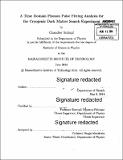| dc.contributor.advisor | Enectalí Figueroa-Feliciano. | en_US |
| dc.contributor.author | Schlupf, Chandler | en_US |
| dc.contributor.other | Massachusetts Institute of Technology. Department of Physics. | en_US |
| dc.date.accessioned | 2015-01-05T20:06:13Z | |
| dc.date.available | 2015-01-05T20:06:13Z | |
| dc.date.copyright | 2014 | en_US |
| dc.date.issued | 2014 | en_US |
| dc.identifier.uri | http://hdl.handle.net/1721.1/92689 | |
| dc.description | Thesis: S.B., Massachusetts Institute of Technology, Department of Physics, 2014. | en_US |
| dc.description | Cataloged from PDF version of thesis. | en_US |
| dc.description | Includes bibliographical references (pages 65-66). | en_US |
| dc.description.abstract | Dark matter makes up 85% of the known matter in the Universe, but the exact nature of dark matter remains unknown. The Cryogenic Dark Matter Search experiment, CDMS, attempts to directly detect the leading candidate dark matter particle, the Weakly Interacting Massive Particle (WIMP), recoiling off of cold germanium crystals. When particles interact with the crystals' atoms, they produce two measurable signals: phonons and ionization. The phonon signal contains information about the event such as its type, energy, and position, and has a much better resolution for lower energy events than does the ionization, especially for nuclear recoils from WIMPs. Because of this, there is a strong motivation for extracting as much information as possible from the phonon signal. For my thesis, the raw phonon pulse signal in the time domain was fit to a functional form based on phonon physics within the crystal. The functional form was carefully checked using the Markov chain Monte Carlo method. A Boosted Decision Tree (BDT) was then used to analyze the parameters from the fits to determine how well the parameters could distinguish between event types such as nuclear versus electron recoil events, and surface versus bulk events. Cuts made on the data, from results of the BDTs that were analyzed with parameters from this time-domain fitting algorithm, yielded better descrimination power than ones that were analyzed with the parameters currently used by CDMS. Applying this method to data mimicking a 15 GeV WIMP distribution produced a 34.4% signal efficiency improvement over the values currently used by CDMS. | en_US |
| dc.description.statementofresponsibility | by Chandler Schlupf. | en_US |
| dc.format.extent | 66 pages | en_US |
| dc.language.iso | eng | en_US |
| dc.publisher | Massachusetts Institute of Technology | en_US |
| dc.rights | M.I.T. theses are protected by copyright. They may be viewed from this source for any purpose, but reproduction or distribution in any format is prohibited without written permission. See provided URL for inquiries about permission. | en_US |
| dc.rights.uri | http://dspace.mit.edu/handle/1721.1/7582 | en_US |
| dc.subject | Physics. | en_US |
| dc.title | A time domain phonon pulse fitting analysis for the cryogenic dark matter search experiment | en_US |
| dc.type | Thesis | en_US |
| dc.description.degree | S.B. | en_US |
| dc.contributor.department | Massachusetts Institute of Technology. Department of Physics | |
| dc.identifier.oclc | 898327867 | en_US |
